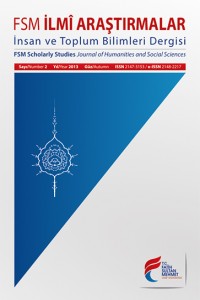Öz
While Edip Cansever, being one of the leading poets of the İkinci Yeni movement,
goes out of the traditional Turkish poetry arc in his poems, tries the untried/ untested, rejects
the available thus showing a nonconformist look; in contrast to the attitude revealed
in style, he studies the drama of individual lives who feel the obligation to comply with
urban life, which he is in and that he cannot interpret, in his poems. This situation- which
results from urbanization, capitalization and the structure of the modern state increasing
the pressure on the individual day by day - appears to be the causes of conformism directly
or indirectly in Cansever. In this study the terms conformist and non-conformist
will be explained and immediately after that, it will be pointed out on the unconformity
of İkinci Yeni in Turkish Poetry from the point of language and style, and the conformist
individual, who is the focus point of Cansever’s poetry, will be examined with the aspect
as how was reflected in his poetry.
Anahtar Kelimeler
Modernism; Urban; Conformism; Nonconformism; İkinci Yeni; Edip Cansever
Kaynakça
- Armağan, Mustafa, Gelenek ve Modernlik Arasında, 2.bs., İstanbul, İz Yayıncılık, 1998.
- Ayhan, Ece, Bütün Yort Savul!lar:Toplu Şiirler, 8.bs., İstanbul, Yapı Kredi Yayınları, 2010.
- Budak, Selçuk, Psikoloji Sözlüğü, İstanbul, Bilim ve Sanat Yayınları, 2003.
- Burke, Peter, Tarih Ve Toplumsal Kuram, Çev. Mete Tuncay, İstanbul, Tarih Vakfı Yayınları, 1994.
- Cansever, Edip, Sonrası Kalır I: Toplu Şiirler, 5.bs., İstanbul, Yapı Kredi Yayınları, 2010.
- Cansever, Edip, Sonrası Kalır II: Toplu Şiirler, 5.bs., İstanbul, Yapı Kredi Yayınları, 2010.
- Cansever, Edip, Şiiri Şiirle Ölçmek, “Geleceğin Şiiri”, Haz. M. Devrim Dirlikyapan, İstanbul, Yapı Kredi Yayınları, 2008.
- Cansever, Edip, Gül Dönüyor Avucumda, 4.bs., Haz. Tahsin Yücel v.d., İstanbul, Adam Yayınları, 1989.
- Dirlikyapan, Murat Devrim, “İkinci Yeni Dışında Bir Şair: Edip Cansever”,
- Bilkent Üniversitesi Ekonomi ve Sosyal Bilimler Enstitüsü, Basılmamış Yükseklisans Tezi, Ankara, 2003.
- Esen, Kerem, “Özgürlük, Ponopticon Ve Kötü Çocuklar”, Virgül, S.29, Nisan 2000.
- Foucault, Michel, Kelimeler ve Şeyler, Çev. Mehmet Ali Kılıçbay, Ankara, İmge Kitabevi, 1994.
- Foucault, Michel, Söylemin Düzeni, Çev. Turhan Ilgaz, İstanbul, Hil Yayın, 1987.
- Fuat, Memet, İkinci Yeni Tartışması, İstanbul, Adam Yayınları, 2000.
- Giddens, Antony, Modernliğin Sonuçları, Çev. Ersin Kuşdil, 4.bs., İstanbul, Ayrıntı Yayınları, 2010.
- Gümüş, Semih, Modernizm Ve Postmodernizm Edebiyatın Dünü Ve Yarını, İstanbul, Can Yayınları, 2010.
- Kahraman, Hasan Bülent, Postmodernite İle Modernite Arasında Türkiye, İstanbul, Everest Yayınları, 2004.
- Kolakowski, Leszek, Modernliğin Sonsuz Duruşması, İstanbul, Pınar Yayınları, 1999.
- Kurt, Ayhan, “Ötesini Söyleyemiyorum”, Ludingirra, S.9, Bahar, 1999.
Öz
İkinci Yeni’nin öncü şairlerinden Edip Cansever, şiirlerinde geleneksel Türk şiir arkının
dışına çıkması, denenmemişi denemesi, hazır sunulu olanı reddetmesiyle nonkonformist
bir görünüm sergilerken; üslupta ortaya koyduğu bu tutumunun aksine şiirlerinde
içerisinde bulunduğu ve anlamlandıramadığı kent yaşamına uymak zorunluluğunu yaşayan
bireyin dramını konu edinmiştir. Kentleşme, kapitalistleşme ve birey üzerinde baskısını
günden güne arttıran modern devlet yapısının neden olduğu bu durum, Edip Cansever’de
konformizmin doğrudan yahut dolaylı sebepleri olarak karşımıza çıkmaktadır. Bu
çalışmada, öncelikle konformizm ve nonkonformizm kavramlarına açıklık getirilecek;
akabinde İkinci Yeni’nin dil ve üslup bağlamında Türk şiiri içerisindeki uyumsuzluğuna
değinilecek ve Cansever’in şiirinin odak noktasını oluşturan konformist birey, onun şiirine
yansıyan yönleriyle incelenecektir.
Anahtar Kelimeler
Modernizm; Kent; Konformizm-Nonkonformizm; İkinci Yeni; Edip Cansever
Kaynakça
- Armağan, Mustafa, Gelenek ve Modernlik Arasında, 2.bs., İstanbul, İz Yayıncılık, 1998.
- Ayhan, Ece, Bütün Yort Savul!lar:Toplu Şiirler, 8.bs., İstanbul, Yapı Kredi Yayınları, 2010.
- Budak, Selçuk, Psikoloji Sözlüğü, İstanbul, Bilim ve Sanat Yayınları, 2003.
- Burke, Peter, Tarih Ve Toplumsal Kuram, Çev. Mete Tuncay, İstanbul, Tarih Vakfı Yayınları, 1994.
- Cansever, Edip, Sonrası Kalır I: Toplu Şiirler, 5.bs., İstanbul, Yapı Kredi Yayınları, 2010.
- Cansever, Edip, Sonrası Kalır II: Toplu Şiirler, 5.bs., İstanbul, Yapı Kredi Yayınları, 2010.
- Cansever, Edip, Şiiri Şiirle Ölçmek, “Geleceğin Şiiri”, Haz. M. Devrim Dirlikyapan, İstanbul, Yapı Kredi Yayınları, 2008.
- Cansever, Edip, Gül Dönüyor Avucumda, 4.bs., Haz. Tahsin Yücel v.d., İstanbul, Adam Yayınları, 1989.
- Dirlikyapan, Murat Devrim, “İkinci Yeni Dışında Bir Şair: Edip Cansever”,
- Bilkent Üniversitesi Ekonomi ve Sosyal Bilimler Enstitüsü, Basılmamış Yükseklisans Tezi, Ankara, 2003.
- Esen, Kerem, “Özgürlük, Ponopticon Ve Kötü Çocuklar”, Virgül, S.29, Nisan 2000.
- Foucault, Michel, Kelimeler ve Şeyler, Çev. Mehmet Ali Kılıçbay, Ankara, İmge Kitabevi, 1994.
- Foucault, Michel, Söylemin Düzeni, Çev. Turhan Ilgaz, İstanbul, Hil Yayın, 1987.
- Fuat, Memet, İkinci Yeni Tartışması, İstanbul, Adam Yayınları, 2000.
- Giddens, Antony, Modernliğin Sonuçları, Çev. Ersin Kuşdil, 4.bs., İstanbul, Ayrıntı Yayınları, 2010.
- Gümüş, Semih, Modernizm Ve Postmodernizm Edebiyatın Dünü Ve Yarını, İstanbul, Can Yayınları, 2010.
- Kahraman, Hasan Bülent, Postmodernite İle Modernite Arasında Türkiye, İstanbul, Everest Yayınları, 2004.
- Kolakowski, Leszek, Modernliğin Sonsuz Duruşması, İstanbul, Pınar Yayınları, 1999.
- Kurt, Ayhan, “Ötesini Söyleyemiyorum”, Ludingirra, S.9, Bahar, 1999.
Ayrıntılar
| Birincil Dil | Türkçe |
|---|---|
| Bölüm | Araştırmalar ve İncelemeler |
| Yazarlar | |
| Yayımlanma Tarihi | 10 Aralık 2013 |
| Yayımlandığı Sayı | Yıl 2013 Sayı: 2 - Güz |


